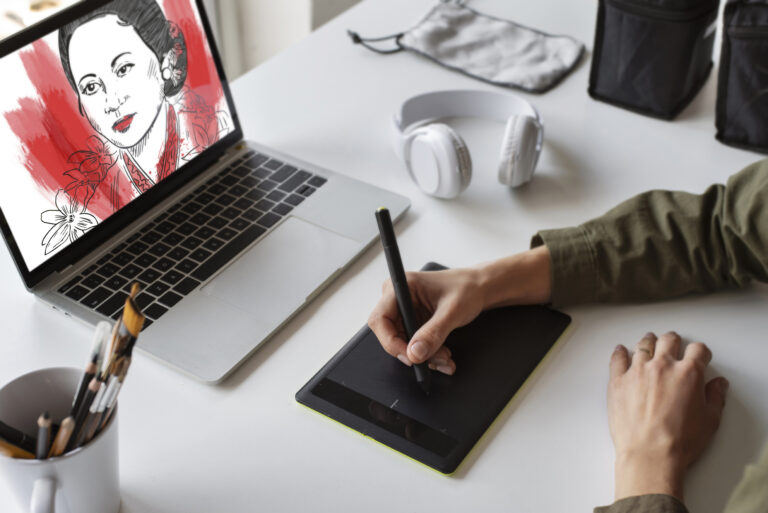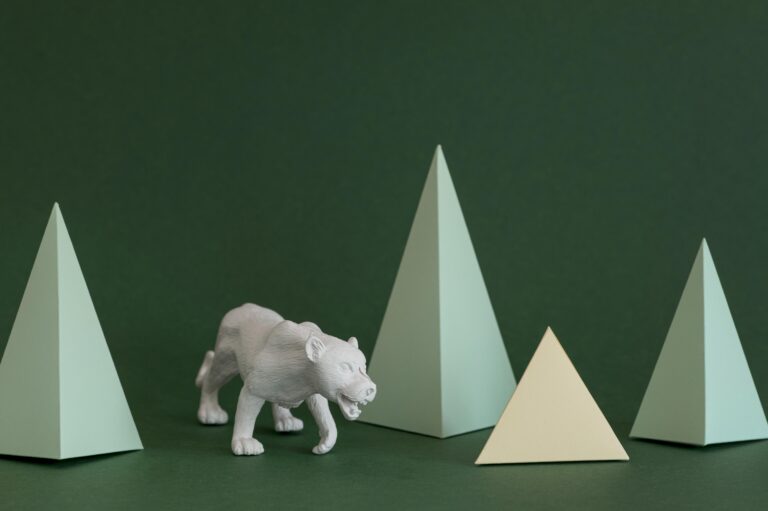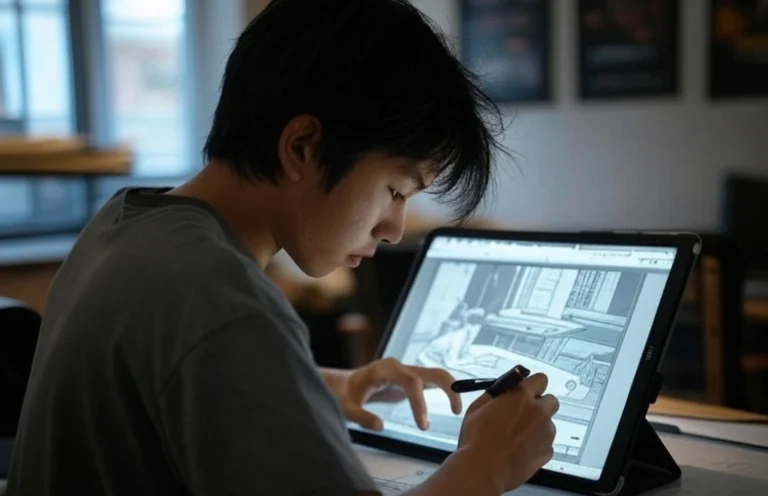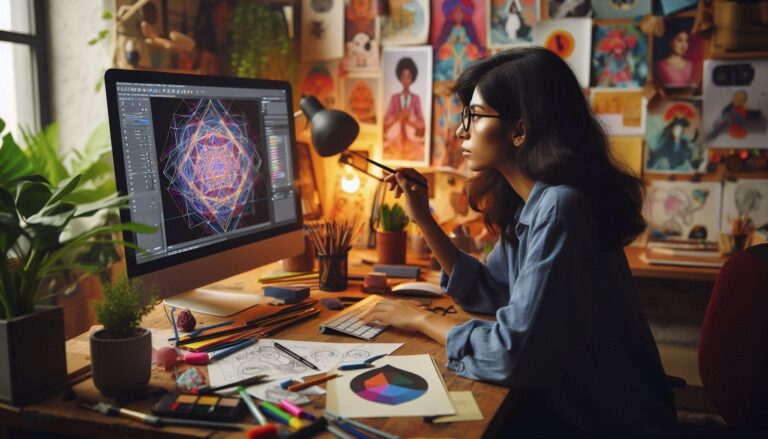Transmedia storytelling is a popular technique to tell a story differently across multiple platforms. In this technique, the story is told differently based on the medium which is used. You can see transmedia storytelling in comics, films, print media, radio, video games, animations, and social media. Each media and platform has its own audience, a special storytelling method, and transmedia strategy. We will also explore some transmedia storytelling examples in this blog.
What Is Transmedia Storytelling?
Transmedia storytelling refers to storytelling across multiple platforms, where each platform makes a distinct contribution to a unified story world. For example, the Star Wars franchise utilizes films to tell the central narrative while TV shows like The Mandalorian expand on side stories. Comic books dive deeper into backstories of characters. Video games allow fans to immerse themselves into the world by taking on the role of key characters. Each platform provides a unique way to engage with the story world.
Based on morphology, transmedia is made of two words, trans as a prefix which means across and media which is what you are using now to understand what transmedia storytelling is. Transmedia storytelling is the technique of telling, designing, and sharing a real or fake story across multiple traditional and digital platforms and media.

Need Animation Services?
Visit our Animation Service page to see how we can help bring your ideas to life!
Transmedia Storytelling Examples
Here are some examples of transmedia storytelling:
Films, TV shows, comic books, novels, video games, and more.
Films, TV shows, comic books, and more.
Comic books, video games, and animated films.
Books, movies, theme parks, and more.
Books, TV shows, and even a video game.
Digital games and videos.
Animation, written articles, and behind-the-scenes clips.

Traditional Storytelling vs. Transmedia Storytelling
The main and first difference is in the number of media that are telling the story. In traditional storytelling, only one platform and medium are used to tell the story. On the other hand, transmedia storytelling uses multiple media and platforms such as books, films, TV shows, animations, video games, and social media (Instagram, Facebook, Twitter,…).
Transmedia storytelling is a more challenging form of storytelling that allows the audience to connect with the story in various ways. However, traditional storytelling is limited and straightforward to a single medium.
With traditional storytelling, audiences passively receive a story through a single medium like a book or film. But transmedia allows audiences to actively engage with a story world across platforms, each providing a unique perspective. Fans can immerse themselves deeper and in different ways, such as following side characters or revisiting favorite elements of the world across various media. It results in a highly interactive, participatory experience.
The Benefits of Transmedia Storytelling
Do you know why is transmeda storytelling important? There are several benefits of transmedia storytelling. Each platform has the ability to provide a unique story that improves the whole plot, character backstories, and world around them. Here is a list of these advantages:
- The power to give audiences a more immersive and engaging experience of a story world.
- The power to provide unique story components.
- The power to help media businesses and content creators reach new and diverse audiences.
In general, transmedia storytelling is a powerful technique for businesses and content creators who wish to develop engaging and enjoyable story worlds by using a variety of platforms and formats.
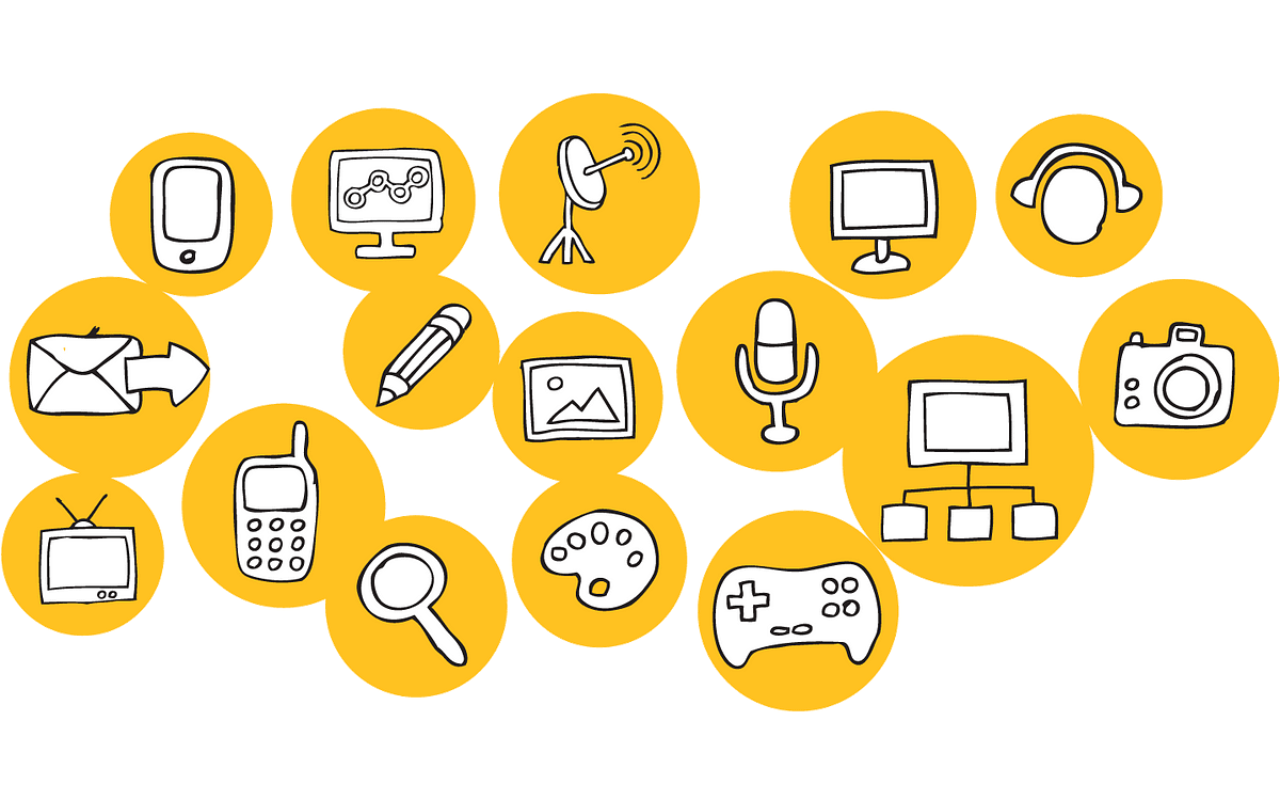
Different Types of Transmedia Storytelling
Animation – The Animatrix short film anthology expanded on the universe of The Matrix through anime. A website with games and activities could engage Harry Potter fans. An influencer-driven social media campaign could generate user-submitted Star Wars fan fiction.
Here are three different versions and ways of transmedia storytelling:
1. Animation
Animation ideas are created to bring the story to life. The animated film could be produced by 3D animation studios and be geared toward children. Bright colors and a catchy soundtrack can be used to appeal to young audiences in the 3D animation pipeline.
Traditional channels like cinemas or television or modern channels like streaming services or YouTube are the media that can be used in this case.
2. Website
An interactive website could be created to let users experience the story uniquely. Games and activities related to the story might engage the audiences, and users could interact with the characters through virtual reality.
The website could also include educational resources that teach children about the themes and morals of the story.
3. Social Media Campaign
Telling the story through a series of short videos or images is another way of transmedia storytelling. These animations for social media and the campaign should be shared on several social media platforms like TikTok, Instagram, Twitter, etc.
Also, it can use famous influencers or celebrities to promote stories. And the last way to use user-generated content is to encourage the audiences to share their own stories about overcoming their feeling.
Read More: Storytelling in Animation
Apply Transmedia Storytelling to Your Marketing
Transmedia marketing can help businesses connect with their target audience more effectively and effectively. Here you can see how to apply transmedia storytelling to your marketing:

Tips for Utilizing Transmedia Storytelling
- Identify unique perspectives different platforms can provide
- Build engaging communities to sustain interest
- Maintain consistency in canon/characters across media
- Leverage the affordances of each medium
- Coordinate messaging and experiences across platforms
What You Will Face in Transmedia Storytelling
Transmedia storytelling poses several challenges in most of the transmedia examples. Some of the challenges include the following:
Maintaining Consistency
Pay attention to the consistency of characters, settings, and plot points in the different media due to the limitations and conventions.
Balancing the Story
Each medium has its own strengths and weaknesses; it’s important to balance the story in a way that takes advantage of the strengths instead of the disadvantages and weaknesses. In addition, maintaining the whole narrative coherence is important to care about.
Audience Fragmentation
Audiences change while platforms change. it’s hard to ensure that the audience is engaged and will follow the story across different platforms or not.
Costs
Transmedia storytelling can be an expensive way of storytelling, as it includes multiple platforms. But if you are a small creator or company, you can decrease the number of platforms to manage costs.
Intellectual Property Issues
Licensing and copyright are some intellectual property issues that you may face during transmedia storytelling. Before starting the process, make sure you know everything about these issues.
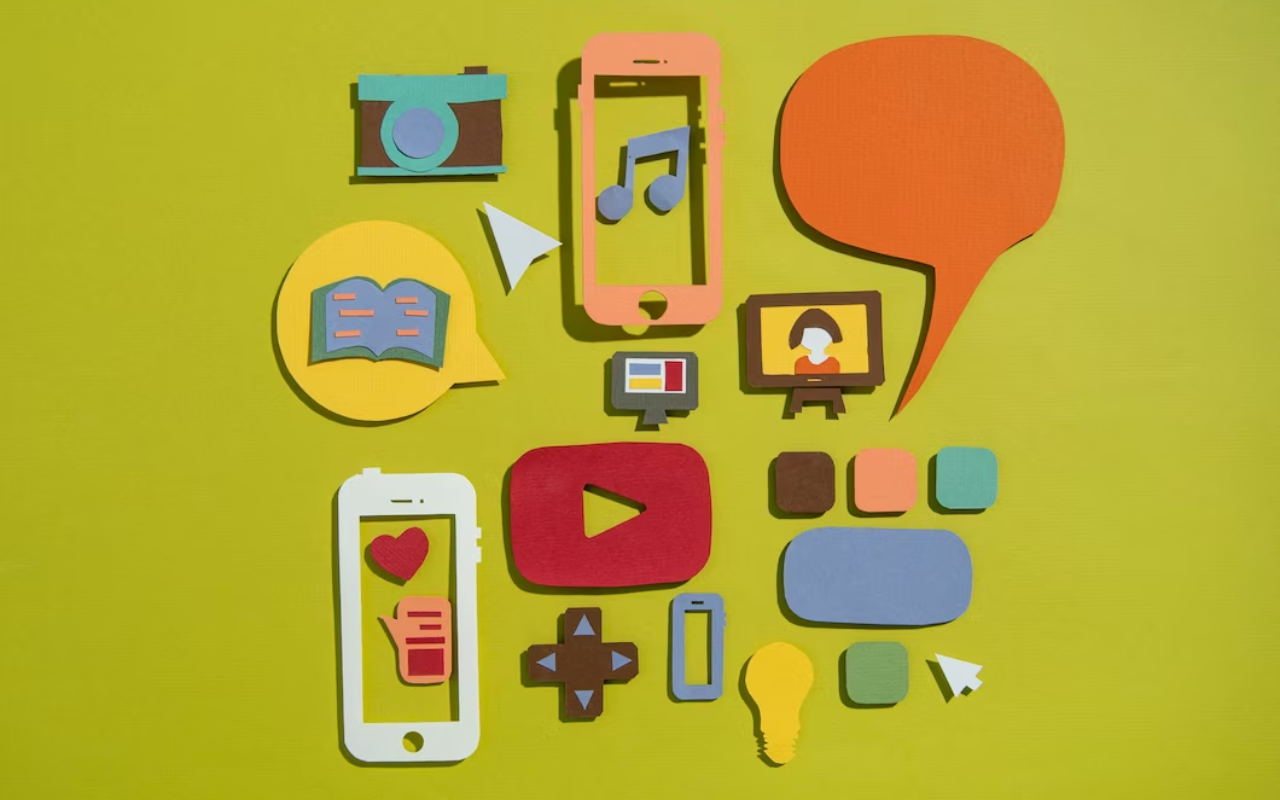
Differences between Transmedia, Multimedia, & Cross-Media
The key differentiator is that with transmedia, each platform contributes something new to the narrative. Multimedia and cross-media focus more on enhancing delivery of core content. Let me know if you need any clarification or have additional questions!
Transmedia | Multimedia | Cross-Media | |
|---|---|---|---|
Definition | Telling a story across multiple media platforms, where each platform makes a distinct contribution | Integration of multiple media formats (text, audio, video, images) within a single platform | Distributing the same content across multiple media platforms |
Goal | Provide unique storytelling experiences tailored to different platforms | Enhance engagement through varied content types in one place | Maximize reach by repurposing content |
Example | Star Wars films, TV shows, books, comics, and video games that build out the story world | News website with articles, images, video clips and audio files | Adapted book released as a film and novel |
Audience Experience | Active participation across platforms lets fans immerse deeper into stories | Rich experience consuming varied aspects of the same core content | Exposure to the same content through different media types |
Canonical Storyline | Core narrative exists, secondary extensions build intricacy | Self-contained story tailored to strengths of incorporated formats | Typically associated with one primary storyline or message |
Timeline of Transmedia Storytelling
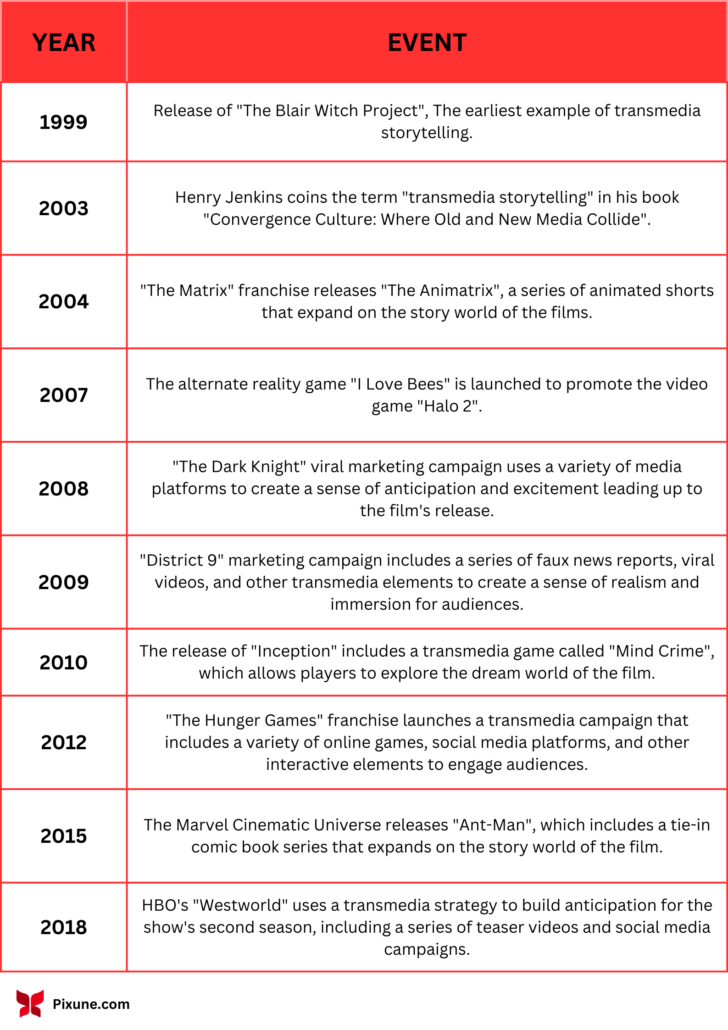
Conclusion
In conclusion, transmedia storytelling is a powerful technique to tell the story across multiple platforms and media with lots of pros, like providing unique story components and engaging experiences, and cons, like maintaining consistency and intellectual property issues.
This kind of storytelling is implemented in transmedia examples like Star Wars, Marvel Cinematic Universe, and Harry Potter in different types of mediums. Transmedia storytelling is expected to continue to evolve and provide new and exciting ways of storytelling.
